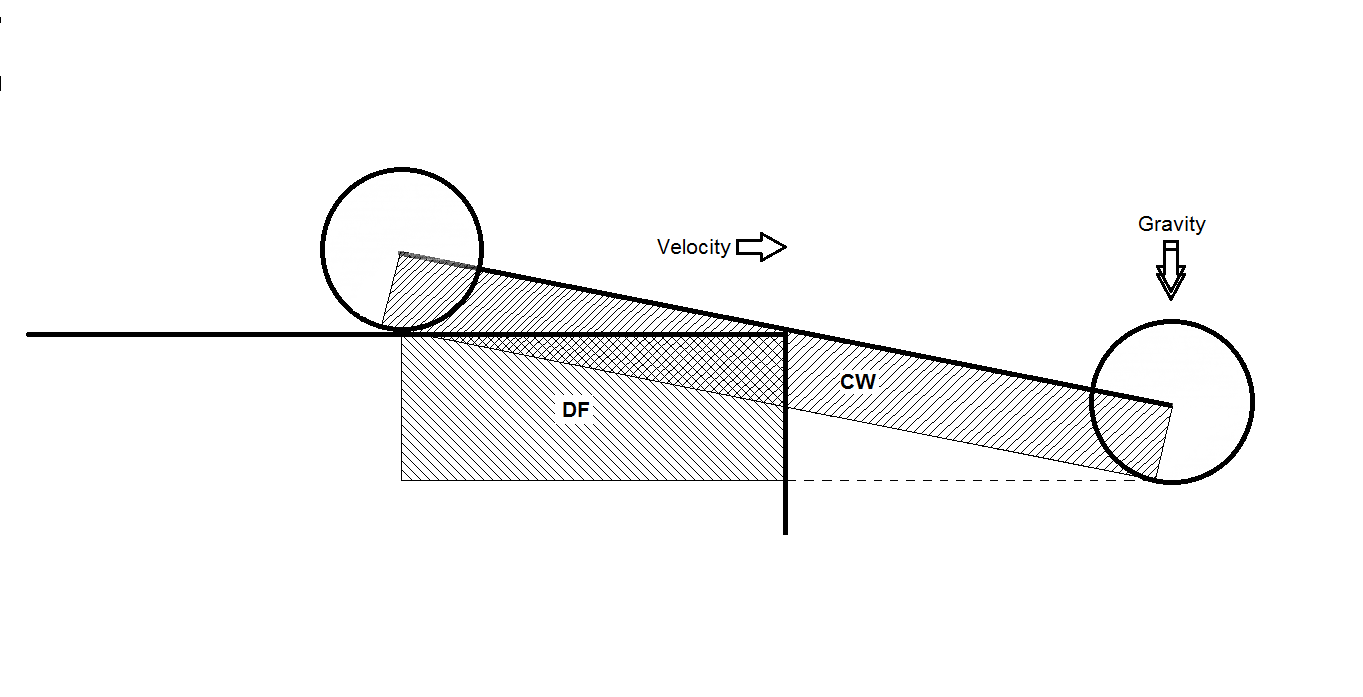The answer (ignoring "pendulum" effects between the two axles) is:
Velocity = sqrt(2 x Gravity) x wheelbase/ (sqrt (27 x clearance))
I have no idea what magic is in 27, but this is NOT a hack; I derived this mathematically. I've written up the derivation in a Word document, but I haven't figured out how to upload the document, nor the spreadsheet I use for checking results.
$$
Velocity = \frac{{wheelbase*\sqrt{2*Gravity}}}{\sqrt{27*clearance}}
$$
The front of the vehicle drops at gravitational acceleration, pivoting on the rear axle as the system moves forward at velocity. When drop at the front times distance from rear axle to edge of the cliff equals wheelbase times (vehicle) clearance, the vehicle touches the edge of the cliff at ONE point.
Taking the first derivative of this equation and setting it equal to zero yields a term for time (t) that can be plugged back into the original equation to yield a velocity that makes the contact point (above) the maximum for the equation.
For a vehicle with 10 feet wheelbase and 1 foot clearance, the critical velocity is 15.40 feet per second (use 32 for Gravity). Zero clearance is at t = 0.43.
Lliam's beautiful (more-realistic, more-sophisticated) answer has inspired me to try again to upload the explanation of MY answer, above. Resemblance between my and Lliam's answer is extensive, and the differences presumably explained by his incorporation of the pendulum effect vis-a-vis the rear axle. The big difference is that his answer uses Wheelbase to the 1.5 power (square root of cube), while mine uses wheelbase in the first order (1).
The solution derives from the geometric observation that the fall of the front of the vehicle times the distance from the rear of the vehicle to the cliff’s edge equals the wheelbase times the clearance at such time(s) as the bottom of the vehicle just contacts the cliff’s edge, or
Distance to edge * Fall of front = clearance * wheelbase DF = CW
 The fall times the remaining distance when there is space between the bottom of the vehicle and the edge of the cliff is always less than the clearance of the vehicle times its wheelbase, so the point where the two products are precisely equal must constitute the maximum value of the fall times the remaining distance. If this product exceeds the product of the vehicle characteristics, then the edge of the cliff and the vehicle are in positive contact (interference).
The fall times the remaining distance when there is space between the bottom of the vehicle and the edge of the cliff is always less than the clearance of the vehicle times its wheelbase, so the point where the two products are precisely equal must constitute the maximum value of the fall times the remaining distance. If this product exceeds the product of the vehicle characteristics, then the edge of the cliff and the vehicle are in positive contact (interference).
The (horizontal) distance to the edge is the wheelbase minus velocity times time; the fall of the front is gravitational acceleration (G) times time-squared divided by 2. Substituting these expressions into the formula above yields:
$$
(wheelbase -(velocity * time)) * \frac{G * time^2}{2} = clearance * wheelbase
$$
Solving this equation for clearance yields:
$$
clearance = \frac{(G * time^2) * (wheelbase - velocity * time)}{2 * wheelbase}
$$
The first derivative of this equation with respect to time is
$$
\frac{dclearance}{dtime} = \frac{2G * time * wheelbase - 3G * time^2 * velocity}{2 * wheelbase}
$$
When this expression evaluates to zero (time >0) and less than the time the rear wheels clear the edge of the cliff, the clearance expression above is at its maximum.
Setting the first-derivative expression above equal to zero and solving for time gives
$$
clearance = \frac{2 * wheelbase}{3 * velocity}
$$
Substituting this expression for time in the clearance expression above gives
$$
clearance = \frac{2G * wheelbase^2}{27 * velocity}
$$
Solving for velocity then gives
$$
Velocity = \frac{wheelbase * \sqrt{2G}}{\sqrt{27 * clearance}}
$$
which yields the minimum Velocity for a given wheelbase and clearance to clear the edge of the cliff without contact with the underside of the vehicle.
Example: a vehicle with a wheelbase of 10 feet and clearance of 1 foot must be moving at a velocity of at least 15.4 feet per second, or 10.5 miles per hour, in order to clear the edge of a cliff without interference between the edge of the cliff and the underside of the vehicle.
This solution takes no account of the lateral acceleration that would in fact occur as the vehicle rotates on its rear axle, a situation comparable to the release of a pendulum at a 90-degree angle. This omission biases the Velocity solutions upward, more as the ratio of clearance to wheelbase increases.
My apologies for using Imperial units. I'm 70 years old, and when I work on my 50-year-old Corvair, I use those units. When working on my Acura, on the other hand, I use only metric units. T & L's 1966 Thunderbird was dimensioned with those units, too.

